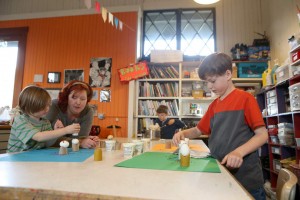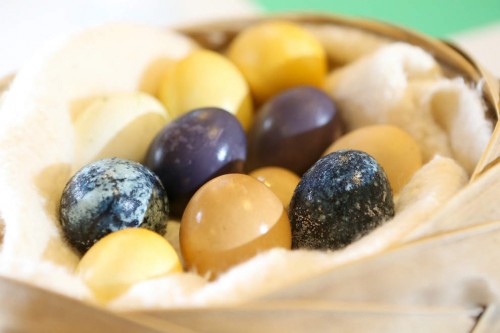This published the week before Easter on March 28, 2015, in the Register-Guard’s Weekend section. I died the eggs–my favorite was the grape juice. It turned out a mottled deep purpley gray with crystals. We also discovered that in order for the crayons to melt like they are supposed to, the eggs need to be right out of the boiling water bath. If they cool off the crayons won’t melt. Unfortunately, these pictures don’t show what the eggs look like if the crayons really melted, but this is a really easy and fun project.
Transform eggs’ plain shells to colorful expressions of the season

Eight-year-old Bailey Becker (right), 5-year-old Sherrif (left) and 7-year-old James Hoopman in background decorate eggs at MECCA., 449 Willamette St. Photo by Collin Andrew/The Register-Guard
Photo by Collin Andrew/The Register-Guard
By Vanessa Salvia
Eggs are rich in symbolic meaning. Pondering whether the chicken or the egg came first reveals the conundrum of creation and birth. Eggs are abundant in spring, a time universally recognized as a new beginning. Eggs themselves are symbolic of abundance and fertility. A plain egg is fine for symbolizing renewal and rebirth, but surely a decorated one does the job even better.
In Ukraine, the oldest pysanky eggs decorated with beeswax and dye date back to the 16th or 15th century. Claudia May, a parishioner at Springfield’s Nativity of the Mother of God Ukrainian Catholic Church, is not Ukrainian herself, but became enamored with the art form five years ago after another parishioner had pysanky kits for sale.
The word pysanka comes from the verb pysaty, meaning to write. “The designs are written on with beeswax,” May says. “It’s a wax-resist technique similar to batik, so you put the wax where you want the color to not be and then you dye it.”
Wax is applied with a small metal funnel on a stick called a kistka. “I heat that in a candle and I scoop up and melt the beeswax into the funnel and then I draw with the wax on the egg,” says May. “The eggs are dyed using progressively darker colors.” Finally, the egg is heated to melt off the beeswax.
Some pysanky artists use their own designs, but May sticks with traditional Ukrainian designs with a lot of symbolism. Symmetry in the eggs is also very important. “There are basic patterns that you divide the egg into so the designs proportionally work out,” she says. “I write on the egg with a fine line with a pencil.”
The eggs are fragile, so some beginning artisans work with hard-boiled eggs. “You can’t drop them on the floor!” May adds with a laugh.
Natural colors
Original pysanky artisans used natural dyes. Nowadays, nonedible aniline dyes are used for vibrant colors. Pysanky are not traditionally eaten, but in Ukraine, hard-boiled eggs colored red using beets or raspberries, called kiashanky, are eaten.
Kitchens are full of natural dyes. Beautiful colors can be created using ingredients such as coffee or tea, turmeric or spinach to create a colored bath for eggs. The richest colors result from leaving the eggs soaking in the colored bath overnight or even longer. Boiling fresh eggs in the dye bath also can result in saturated color. Natural dyes tend to fade over time, so hollow out any eggs you wish to keep and spray with a matte or gloss acrylic varnish.
Colors don’t always turn out to be what you expect using this method. For instance, in my experimentation I learned that a small beet simmered in two cups of water turned an orangey red, while eggs soaked in beet juice turned a rich maroon. Red cabbage actually produces a blueish hue. Adding vinegar can deepen or even change the color completely. For example, a recipe from Better Homes and Gardens states that jade green dye can be created by simmering the peel from six red onions in 2 cups of water for 15 minutes before straining and adding 3 teaspoons of white vinegar.
Experimental fun
Experimenting to see what happens is part of the fun of crafts like this. Maiya Becker, the board president of Eugene’s Materials Exchange Center for Community Arts (449 Willamette St.; materials-exchange.org), is an expert in using unusual materials in art projects. MECCA’s specialty is diverting materials from the waste stream and making them available for artistic reuse. In Becker’s hands, eyeglass lenses become jewelry and crayons become a sort of tie-dye for eggs. “This is a great use for old or little crayon stubs which MECCA has lots of for a very low price,” Becker says. “There’s also the science aspect to this. It’s teaching color theory.”
Remove the crayon wrappers, cover your workspace with newspaper and use a cheese grater that you won’t use for food again to grate the crayons into tiny shavings. “We grated each color separately and put them in old yogurt containers, but you can grate all the colors together to create a rainbow/tie dye effect,” she says.
Becker says this craft is an opportunity for people who don’t feel artistic or aren’t art-trained to engage in the creative process. “One of the things I like about projects like this that people do every year is that people don’t think of it as art, but it is,” she says. “Cookie making at Christmastime is also an art form.”
Becker cuts toilet paper tubes in half and folds down the edges to create an egg holder. When the crayon shavings are sprinkled on very hot eggs, the crayons melt, creating a swirly tie-dye effect. “You can even pile some shavings on the paper and roll the eggs around in it,” she says. “Experiment and see what works. That’s the cool thing about it.”
Melted Crayon Easter Eggs
(From Maiya Becker, MECCA)
Hard-boiled eggs
Crayons
Cheese grater (make it your crafts-only grater as it will be unusable for food)
Egg holder (can use toilet paper rolls shaped to hold eggs)
Glitter (optional)
Peel wrapper from crayons. (Soak your crayons in warm water for 15 minutes to loosen the wrappers.)
Using cheese grater, grate crayons to make shavings.
Boil eggs. Once they are cooked, keep them in a pot with hot water. Fish out one egg at a time and dry it off in a towel. Place hot egg on egg holder.
Sprinkle little bits of crayon shavings onto the egg. The heat from the egg will melt the crayon. Optional: Sprinkle egg with fine glitter while crayons are melting to make it especially decorated.
Allow eggs to cool completely and crayons to finish melting before storing back into egg carton. You also can move your eggs in their egg holders into the fridge to speed up cooling time.
Homemade Natural Egg Dye
Brown: Soak eggs in 1 quart strong black coffee.
Orange or maroon: Juice a beet or simmer a diced beet in 2 cups of water before adding eggs.
Yellow: Simmer 2 tablespoons turmeric in 2 cups of water; cool before adding eggs.
Light green: Simmer 1 cup spinach in 2 cups water. Allow the spinach to sit in the water overnight to deepen the green color before adding eggs.
Mottled purple: Allow eggs to soak in undiluted grape juice.

No comments yet.